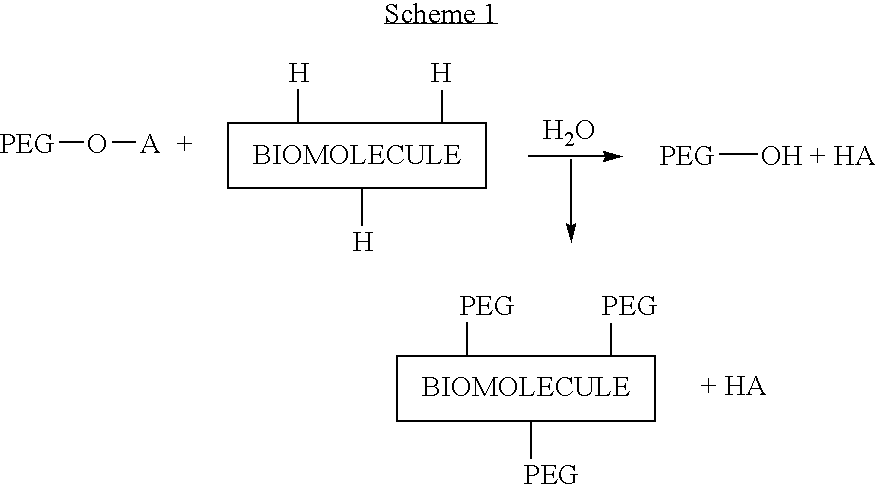Activated polyethylene glycol compounds
- Summary
- Abstract
- Description
- Claims
- Application Information
AI Technical Summary
Benefits of technology
Problems solved by technology
Method used
Image
Examples
example 1
Synthesis of 4-Carboxyphenyl Isothiocyanate
[0081]Para-aminobenzoic acid (0.2 moles; 26 grams of 99 percent pure from Aldrich Chemical, Milwaukee, Wis.) was dissolved in acetone (400 mL) at room temperature (about 20 degrees Celsius). Activated carbon (about 5 grams; Darco® G60) was added, and the mixture was stirred (magnetic stir bar) for 5 to 10 minutes. The entire solution was filtered, yielding a much lighter-colored solution of p-aminobenzoic acid than was initially formed.
[0082]Sodium acetate (0.3 moles, 25 grams; dissolved in about 200 mL of deionized water) was added to the filtrate, now contained in a 4 liter vacuum flask. A vacuum was applied to the flask with an intermediate dry ice / acetone trap between the 4 liter flask and the vacuum pump. Reduced pressure was maintained until much of the original acetone had evaporated off of the p-aminobenzoic acid solution (down to about 300 mL volume). The flask was chilled to between about zero and five degrees Celsius.
[0083]Thioph...
example 2
Synthesis of 4-Isothiocyanobenzoyl Azide
[0086]A portion of the 4-carboxyphenyl isothiocyanate (15 grams) from Example 1 was suspended in dry methylene chloride (200 mL) in a 1 liter side-arm vacuum flask, along with pyridine (16 grams; 0.2 M), phenyl dichlorophosphate (Aldrich Cat. No. P. 2, 238-9; 0.1 M) and sodium azide (6.5 grams; 0.1 M). The mixture was stirred overnight (about 15 hours) at room temperature. The stirred mixture was then washed in a separatory funnel with water (200 mL) and then sulfuric acid (200 mL of 0.1 N H2SO4). The acid-washed methylene chloride layer was dried with anhydrous magnesium sulfate (MgSO4).
[0087]The dried methylene chloride reaction solution was evaporated under vacuum in a rotary evaporator at room temperature or lower (less than or equal to about 20° C.). The resulting light tan crystals were dissolved in a minimum of ethyl ether at room temperature. The re-crystallization solution was treated with activated carbon (Darco® G60) and filtered. T...
example 3
Synthesis of 4-Isothiocyanophenyl Isocyanate and PEG Reagent
[0089]The nearly white 4-isothiocyanobenzoyl azide from Example 2 was thermally decomposed at about 75°-104° C. (Curtius Rearrangement) smoothly and quantitatively as a solution in dry refluxing toluene. The resulting 4-isothiocyanophenyl isocyanate (also known as 4-isocyanophenyl isothiocyanate, shown below) product is represented by the following chemical formula. The 4-isocyanophenyl isothiocyanate was not isolated, but reacted as formed in situ with the hydroxyl-containing PEG according to the following description. An infrared spectrum of the composition containing 4-isocyanophenyl isothiocyanate showed the decrease in the azide band at about 980-1000 cm−1 along with increased complexity of the absorbance in the N═C═O and N═C═S region of the spectrum from about 2000 to about 2300 cm−1.
[0090]A 2-liter, 3-necked flask was equipped with a thermometer, overhead stirrer with motorized drive, heating mantle with rheostat, s...
PUM
| Property | Measurement | Unit |
|---|---|---|
| Chemical formula | aaaaa | aaaaa |
Abstract
Description
Claims
Application Information
 Login to View More
Login to View More - R&D
- Intellectual Property
- Life Sciences
- Materials
- Tech Scout
- Unparalleled Data Quality
- Higher Quality Content
- 60% Fewer Hallucinations
Browse by: Latest US Patents, China's latest patents, Technical Efficacy Thesaurus, Application Domain, Technology Topic, Popular Technical Reports.
© 2025 PatSnap. All rights reserved.Legal|Privacy policy|Modern Slavery Act Transparency Statement|Sitemap|About US| Contact US: help@patsnap.com



